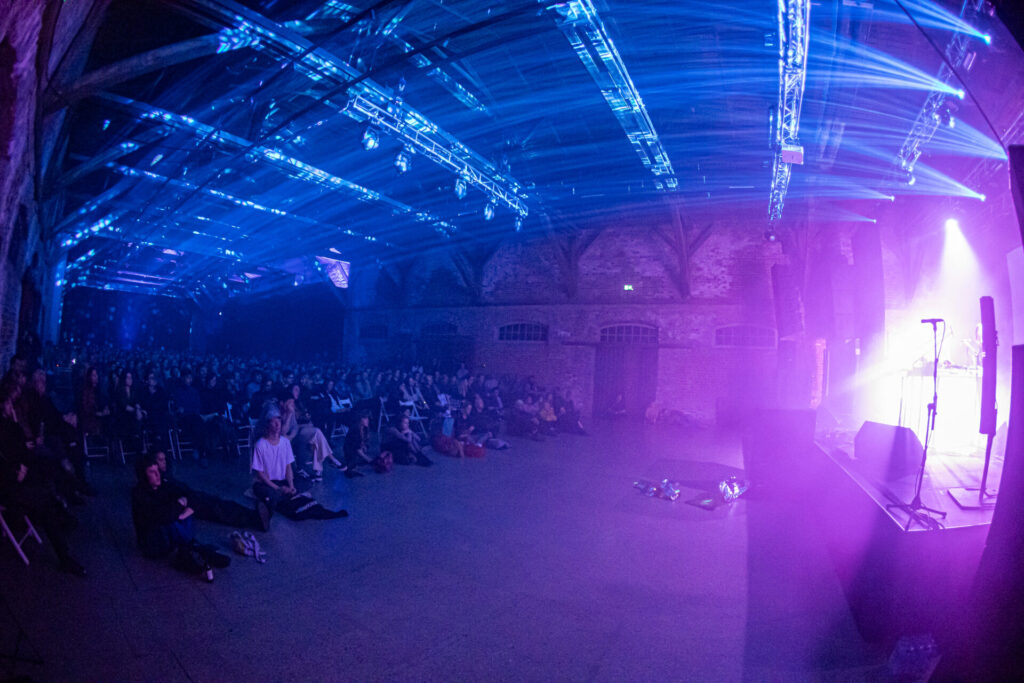Riga’s Skaņu Mežs (Sound Forest) is uniquely suited to a time when the notion of identifying a singular fashion, zeitgeist or direction of travel through adventurous music is woefully outdated. The format of the festival full-heartedly embraces the plurality of radical sounds tumbling out into the world and the opportunity to be gleefully disorientated that provides, the bold curation which sets the festival apart shining especially brightly for the 2024 edition.
In the 22 years since its first iteration, Skaņu Mežs has roamed between different sites around the Latvian capital, from new-Rococo cinemas to theatres. For the last few it has settled at Hanzas Perons, a former railway cargo warehouse converted into a permanent concert hall. The venue is a short walk from the city’s Old Town and, somewhat ironically, an even shorter walk from the ornate art nouveau facades of Riga’s ‘quiet centre’. For the 2024 edition, Hanzas Perons hosts the two core nights of the festival. After an opening event a weekend prior on the other side of the city, the week leading up to the festival proper sees a series of free lectures and workshops by artists performing at the festival in venues owned by Riga’s Art and Music academies.
There is no shortage of inner-city festivals in Europe each autumn and winter, but where some have audiences regularly moving between different sites in a city, spreading sets out both in space and time, Skaņu Mežs goes for a more condensed approach, at least for the two nights at Hanzas Perons. While festivals like Rewire or Semibreve take you on a voyage through a city, Skaņu Mežs reaches for a more situated adventure, focusing instead on an extended journey through radical sound. Which is to say, while all the festivals just mentioned have varied lineups, there is something unique in the way Skaņu Mežs present theirs. Key to the event’s success is that the curators are not afraid to abruptly jump genre boundaries. A particularly mesmerising sequence on Friday sees the absurd theatrics of duo Neil Luck and Jennifer Walshe followed by relentless harsh noise wall innovator Vomir, and then a scintillating solo guitar set from Fred Frith. All the while, installations from Tintin Patrone and Nick Klein diffuse outside the main hall.
In the wrong hands such jumps condensed into five or six hours could be overwhelming, but Skaņu Mežs makes it work by making the transitions never seem arbitrary. While it can be an intense experience, it’s undoubtedly also an invigorating one. If you surrender to the festival’s tempo it becomes a site of glorious discombobulation, an amplification of music’s ability to disrupt, jolt and catapult us out of the mundane. But it never feels like a jumble. Threads start to emerge, unlikely intersections and odd interactions. The move between Luck and Walshe and Vomir is a case in point. The former stretch the boundaries of music performance, hitting a beguiling space between live action Hörspiel, cabaret and fourth wall bending performance art. Vomir, face bagged, totally motionless as a torrent of pre-recorded noise blasts out, is anti-performance as meticulously executed performance. On the one hand these two sets are unrelated, on the other they’re obverse faces of the same coin.
Themes and threads emerge through the festival, but they’re there for the audience to discover rather than being dictated. Throughout the event are artists dabbling in the overlapping fields of sound poetry and extended vocal techniques. It’s there in Walshe and Luck’s set, with Charmaine Lee, and in Latvian composer Gundega Šmite’s composition performed by Gunta Gelgoté. It’s fascinating and timely. Rich histories flow into sound poetry and extended vocal technique, whether avant-garde movements such as Dada and Lettrism, jazz vocal techniques such as scat, or supernatural glossolalia. For a long time the more extreme ends of vocalisations outside melodic singing and conventional language could be wildly provocative, capable of triggering violent responses from audiences, as Jaap Blonk discovered when trying to perform Kurt Schwitter’s Ursonate at a punk gig in 1986. As Skaņu Mežs shows, sound poetry’s ability to incite an actual riot has dissipated, its techniques integrated into the texture of experimental sound practices. But through its engagement with the contingency and fallibility of language, expression and comprehension, it’s taken on new pertinence in our social media- connected, AI-augmented, increasingly divisive age. These ideas, although playfully, feel acutely present in Luck and Walshe’s elegantly timed swings between barely sensical disconnection and sudden synchronicity. But the possibilities and questions are also explored, albeit less explicitly, in other sets.
Elsewhere, Skaņu Mežs 2024 focuses on extreme heaviness outside the traditional, macho posturing of rock. A set from the Body and Dis Fig is the obvious lodestar for this, but immense weight also emerges from Dharma Doom, Deli Girls, and the righteous bass underpinning Armand Hammer. None has a guitar in sight. Only the Body and Dharma Doom use live drums. Yet all are delivered with enough force to feel like a genuine risk to the structural integrity of the venue.
While there are themes and standout sets to unpick through Skaņu Mežs, the real joy is strapping yourself in for the ride the festival delivers. A challenging journey which never fails to surprise and thrill. While Deli Girls’ ferocious auto-tuned gabba-pop-metal, and the sets from The Body and Dis Fig, Raven Chacon and Armand Hammer are all phenomenal, the real key to what makes Skaņu Mežs so effective are those artists you’re less likely to see playing elsewhere. That’s the reasoning underpinning many of the six highlights picked below, with some exceptions.
Autechre
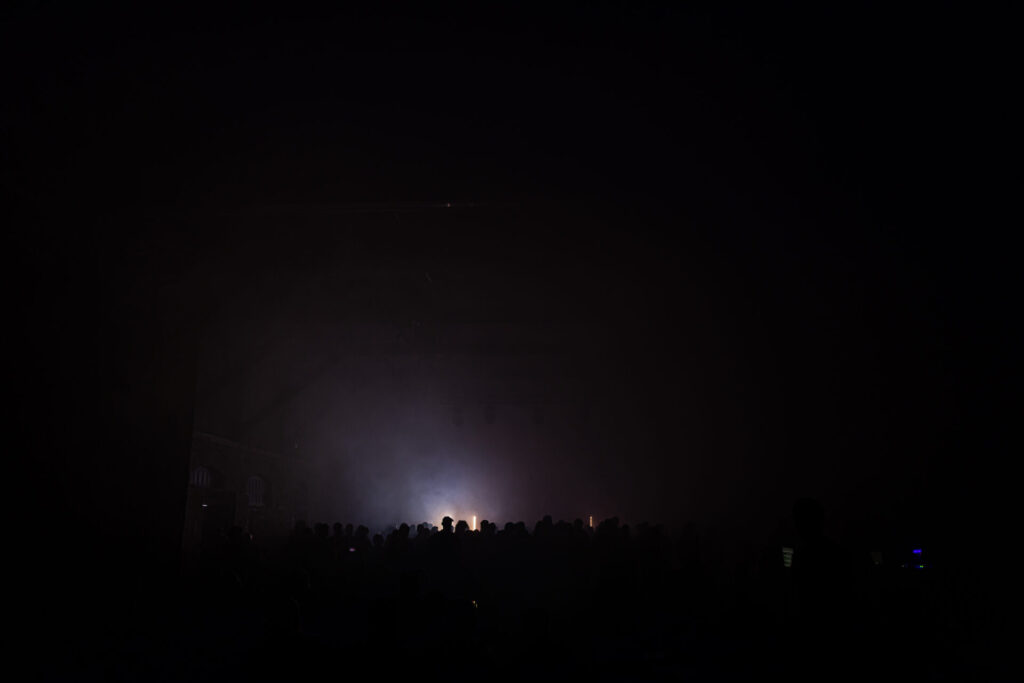
I spend the afternoon leading up to the Friday evening at Hanzas Perons in a fog of distraction and anxiety. A day bouncing between emails, deadlines and excessive scrolling leaves my mind feeling frustratingly dispersed and incapable of focusing. Pausing in one of Riga’s many beautiful parks fixes me a little, but it’s Autechre’s set on Friday night which completely re-grounds me. A lot is written about the hows and whys of the duo’s music: technology, performance, and the balance between generative and composed. What Autechre’s Skaņu Mežs show really brings home is just how therapeutic it is to be in a packed, pitch-black room while Autechre’s music surges through your mind and body. The set is distinct from those documented on many of their recent live collections, and it’ll be interesting to see if this is a new phase or an anomaly. There are seeming call backs to tones and textures, if not actual material, from Tri Repetae and Quaristice. There are vague nods to hip hop in the way sounds are scratched and warped in a manner similar to (but almost certainly not actually) turntablist techniques, while the beats frequently lock into monumental cyborg dub. But this is Autechre, and those retro tints are glimpses rather than an overarching theme, especially in the set’s pounding second half. Predominantly, it’s an hour of metallic texture and what sound like malfunctioning electronics harnessed into ecstatic body music. A constantly reformatting, alien quantized slab of braindance which never stops grooving, even when the bpms reach dizzying highs towards the set’s close. For all the abstraction in their sound, at Skaņu Mežs Autechre’s music hits at a visceral, instinctive level. It’s head music grounded in the communal and celebratory energy of club spaces. A reflection of an overstimulating world and a means to momentarily escape it.
Charmaine Lee
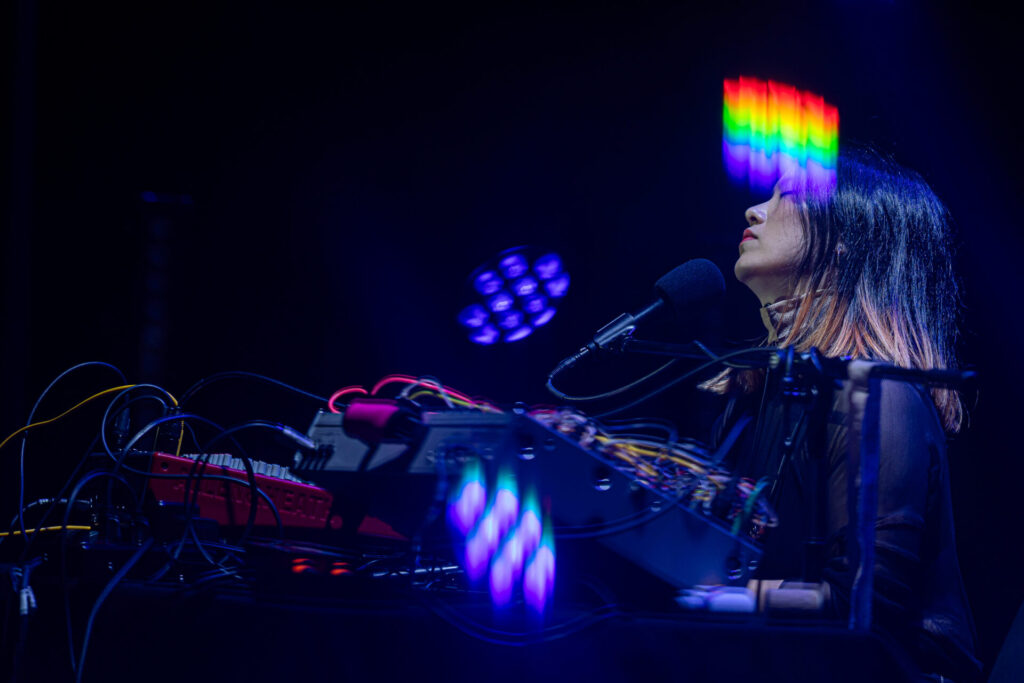
At times, Australian-born, New York-based Charmaine Lee’s set feels like a descendent of the work of François Dufrene and Henri Chopin as she burbles and gurgles into a cassette dictaphone. But Lee builds on their techniques and sense distorting strategies, taking her voice and electronics into a far more dynamic, multilayered and hyper-vivid space. Her performance is full of fidgety energy, at points sounding like she’s beatboxing an approximation of the spontaneity and rhythmic intricacy of free-jazz drum solo. Elsewhere, she swings brilliantly between babbling phonemes and sudden interjections of comprehensible language, or haptically sculpts feedback tone with a microphone. It’s a powerfully expressive, wonderfully unpredictable performance which rides the possibilities of composing in the moment. On paper, having her play immediately before Autechre seems an unusual decision. In practice it’s a masterstroke. Her approach and tools are radically different to Autechre’s: Lee’s music is rooted in bodily performance and far removed from computer music. Yet the intricate, shapeshifting layers and endlessly shifting dynamics she summons feel as much connected to Autechre as the history of sound poetry. A bamboozling, fully immersive display of the evocative possibilities hidden in abstract sounds, her set also shows the unlikely connections Skaņu Mežs are so good at highlighting.
Tintin Patrone
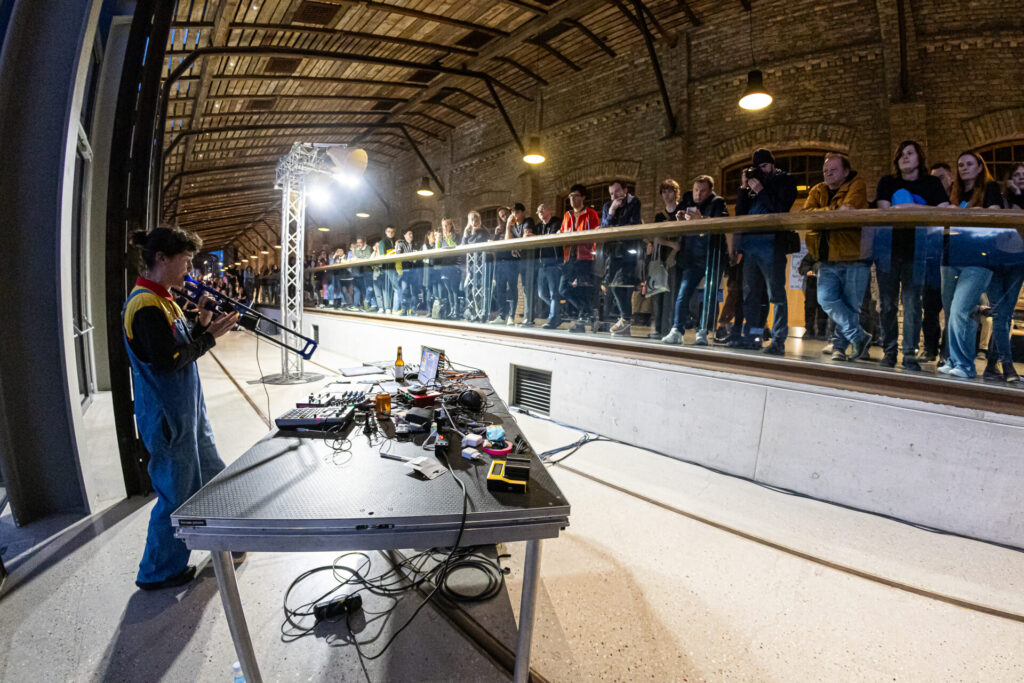
I’ve wanted to see Tintin Patrone, aka Christina Koehler, live since hearing her hooligan themed tape from earlier this year, Bocklos Am Wegesrand. For Skaņu Mežs, she plays a live set which segues into an installation, Pure Minor. And that installation remains playing throughout the two evenings at Hanzas Perons. Both take traditional “Alpsegen” as their theme, an evening litany by shepherds and dairy workers in the Swiss Alps in which they call for protection from the potential threats of the coming night. These calls are amplified through folle, milk funnels which they hold to their mouths as megaphones. Tintin Patrone reimagines these rituals through a mix of voices both sampled from online libraries and AI generated, alongside her trombone playing. In doing so, she transposes the form of Alpsegen into a far more contemporary environment, seemingly asking what they might become outside of a rural Alpine setting. For the live performance, groans and volatile drones from her alto trombone are processed through electronics and accompanied with samples, sharp jumps and drops in volume creating a thrillingly unstable soundscape. A truly feverish energy takes hold, the set culminating in riotous cacophony as she mashes two samplers with her fists to trigger recordings of airhorns and other peculiarly out of place sounds. The installation sustains this vibrancy. A robotic deer roams around the venue, bleeting out strange vocalisations somewhere between animal and human, while pre-recorded trombone glissandos duet with babbles of voices diffused through a quartet of speakers shaped like folle. Intriguing and richly layered, Patrone’s work both live and installed also has a playfulness and transparency that’s utterly compelling. Though complex, her pieces never get consumed by theoretical or academic posturing. It’s disarmingly moving, often raucous, occasionally hilarious in the serendipitous sonic events that occur. A playful, constantly evolving accompaniment to the festival that I frequently find myself dipping back into between acts.
Gundega Šmite and Gunta Gelgote
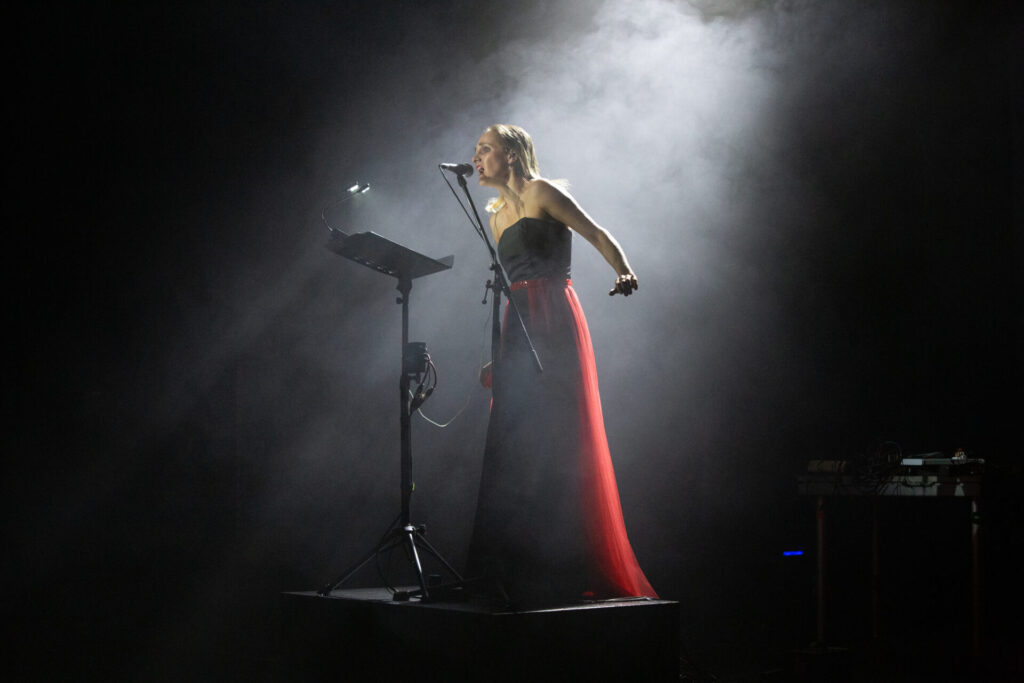
Gundega Šmite is a Latvia-born, Greece-based composer, poet and short story writer. Four Electroacoustic Love Poems is a piece commissioned for Skaņu Mežs and performed by singer Gunta Gelgote. The whole performance makes startling use of space and atmosphere. Gelgote’s voice swings between celestial opera, spooky mutterings and feral glossolalia, some of which seem to come from her voice alone, others electronically triggered. Around the vocal come spectral thuds of piano and ominous throbs of bass. The whole performance lasts barely ten minutes. But brevity only adds to the music’s apparitional quality, a sense we’re witnessing an intrusion from a supernatural realm. A reference point would perhaps be the more spectral ends of the GRM studio’s output, works by artists such as Beatriz Ferreyra or Lionel Marchetti, while the fact Gelgote is wearing a red dress on an eerily lit stage can’t help but trigger Twin Peak’s associations. What makes Electroacoustic Love Poems so effective is the sense in composition and performance that we’re witnessing something beautiful becoming possessed in real time. As though sounds melodious and romantic are wrestling with sinister interlopers before our eyes and ears. The whole performance is a masterful grappling with uncanny spookiness.
Dharma Doom
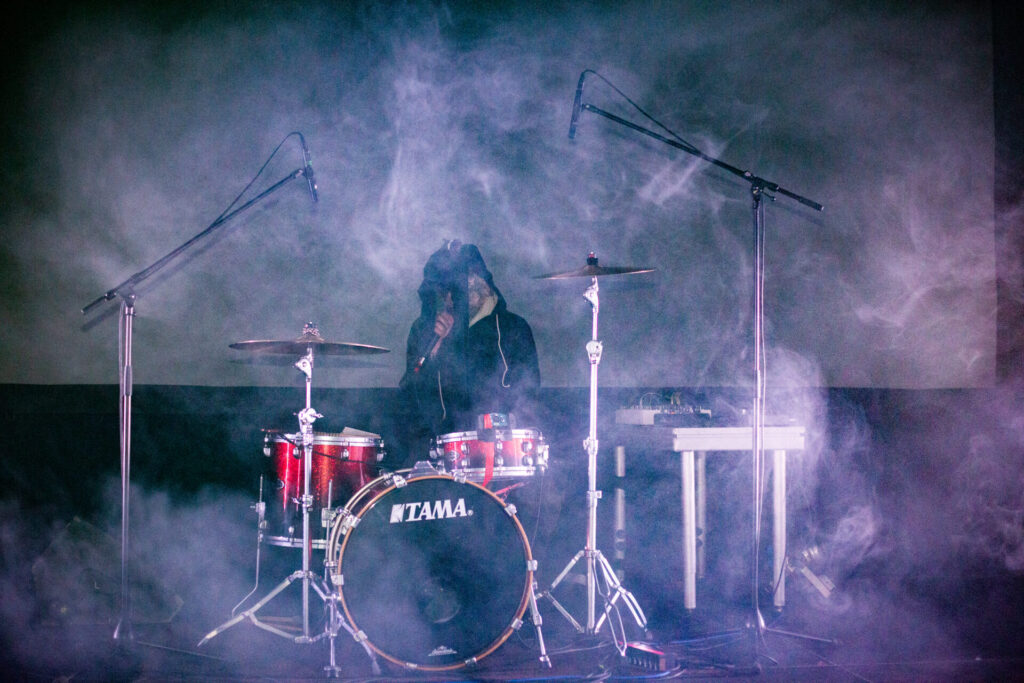
As well as showcasing artists from Latvia, one of Skaņu Mežs strengths is highlighting vital underground scenes in the neighbouring Baltic states. Dharma Doom is affiliated with the Shelter collective in Tallinn, Estonia. A record label and event series which strives to diversify Tallinn’s club scene beyond the rigid grids of four-four techno while also raising funds for humanitarian causes. Dharma Doom plays the festival’s penultimate set, and the heaviest in terms of both sheer weight and pure disturbing dread. Quite the triumph considering he’s following the double blast of The Body and Dis Fig and Deli Girls. Masked and barely visible beneath a wall of frosted light and smoke, he moves between electronics, screams and occasional interventions on a bare bones drum kit in a set which includes his solo pieces as well as interpretations of tracks from his band projects: KEETAI and Dharma Coil. Beginning with a cursed soundscape full of incessant clock-like sounds, a blood curdling scream arrives whose disturbing power I feel is now permanently scorched into my subconscious. From there come blasts of cauterised electronics, snare drums that sound like branches snapping, and a bludgeoning throb of bass. Despite playing through a vast soundsystem in a massive hall, there’s a disturbing proximity to the sounds he uses, unhinged events that make you look over your shoulder as you succumb to the music’s pounding intensity. Vicious and visceral, Dharma Doom displays immense awareness of sound’s ability to disturb. Fusing metal, noise and club music ideas without ever easily fitting into one idiom, he stays in a state of hypnotic foreboding without ever tipping over the edge into horror cliché. While Dharma Doom’s set is far from a comfortable listen, the uncompromising intensity and sinister mood he sustains is thrilling.
Aaron Edgcomb and Kirsten Carey
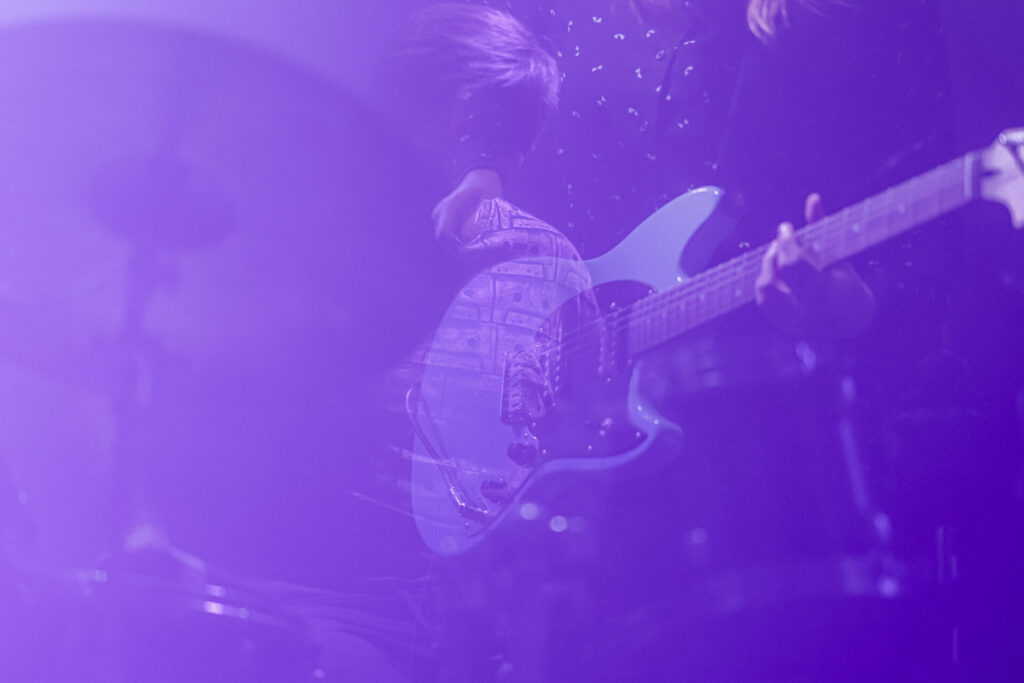
Aaron Edgcomb (drums) and Kirsten Carey (guitars) play a week before the festival proper, in the opening event at Laska V21, located in a small quarter of bars in Riga’s Latgale neighbourhood. An area which, to reach on foot from the city centre, involves a lovely stroll through blocks of cobbled streets and wooden houses. Initially, I find Carey and Edgcomb’s interaction frustrating. They seem to sit in a place of indecision. Their shards of atonal guitar and intricate percussion don’t gel. Neither do they completely jettison each other to explore the possibilities of fully free form, untethered improvisation. But, as they play on, I find the awkward middle ground increasingly compelling, realising that, as a listener I’ve been listening out for the wrong thing. Carey’s guitar playing, often plucked and fretted with metallic objects rather than pick or fingers, is so razored that describing it as angular doesn’t come close to conveying how serrated it is. Edgcomb’s drumming increasingly takes in the pointillistic intensity of a hailstorm. There’s no catharsis or crescendo in their instrumentals. They never resolve but dwell in precise but precarious torsion, the tension they summon typically ending with an abrupt halt. As their set progresses I can’t help but be enthralled by the coarseness they embrace and the landscape of gnarled metals they elicit. Where several acts at Skaņu Mežs explore heaviness beyond rock instrumentation, Carey and Edgcomb stretch the expressive possibilities of guitar and drums. Their playing is like being dropped into a debris field. Initially perplexing, the duo’s strength is their ability to work with wrecked components, corralling the shrapnel into something transfixing.

